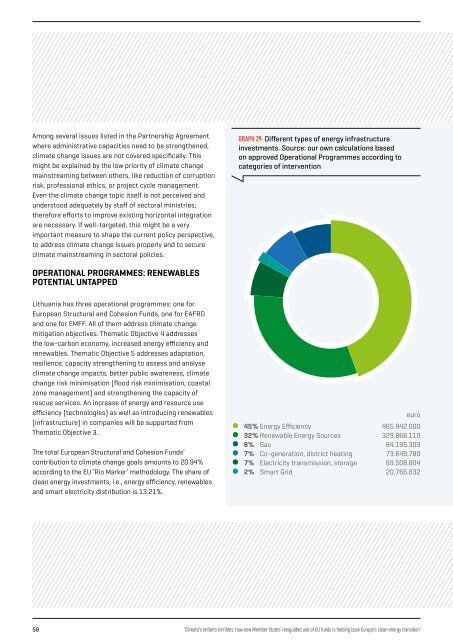ENFANTS TERRIBLES
enfants-terribles
enfants-terribles
You also want an ePaper? Increase the reach of your titles
YUMPU automatically turns print PDFs into web optimized ePapers that Google loves.
Among several issues listed in the Partnership Agreement<br />
where administrative capacities need to be strengthened,<br />
climate change issues are not covered specifically. This<br />
might be explained by the low priority of climate change<br />
mainstreaming between others, like reduction of corruption<br />
risk, professional ethics, or project cycle management.<br />
Even the climate change topic itself is not perceived and<br />
understood adequately by staff of sectoral ministries;<br />
therefore efforts to improve existing horizontal integration<br />
are necessary. If well-targeted, this might be a very<br />
important measure to shape the current policy perspective,<br />
to address climate change issues properly and to secure<br />
climate mainstreaming in sectoral policies.<br />
GRAPH 29: Different types of energy infrastructure<br />
investments. Source: our own calculations based<br />
on approved Operational Programmes according to<br />
categories of intervention<br />
OPERATIONAL PROGRAMMES: RENEWABLES<br />
POTENTIAL UNTAPPED<br />
Lithuania has three operational programmes: one for<br />
European Structural and Cohesion Funds, one for EAFRD<br />
and one for EMFF. All of them address climate change<br />
mitigation objectives. Thematic Objective 4 addresses<br />
the low-carbon economy, increased energy efficiency and<br />
renewables. Thematic Objective 5 addresses adaptation,<br />
resilience, capacity strengthening to assess and analyse<br />
climate change impacts, better public awareness, climate<br />
change risk minimisation (flood risk minimisation, coastal<br />
zone management) and strengthening the capacity of<br />
rescue services. An increase of energy and resource use<br />
efficiency (technologies) as well as introducing renewables<br />
(infrastructure) in companies will be supported from<br />
Thematic Objective 3.<br />
The total European Structural and Cohesion Funds’<br />
contribution to climate change goals amounts to 20.94%<br />
according to the EU ‘Rio Marker’ methodology. The share of<br />
clean energy investments, i.e., energy efficiency, renewables<br />
and smart electricity distribution is 13.21%.<br />
euro<br />
45% Energy Efficiency 465.942.000<br />
32% Renewable Energy Sources 329.868.110<br />
8% Gas 84.195.303<br />
7% Co-generation, district heating 73.649.780<br />
7% Electricity transmission, storage 69.508.804<br />
2% Smart Grid 20.766.632<br />
58<br />
‘Climate’s enfants terribles: how new Member States’ misguided use of EU funds is holding back Europe’s clean energy transition’


